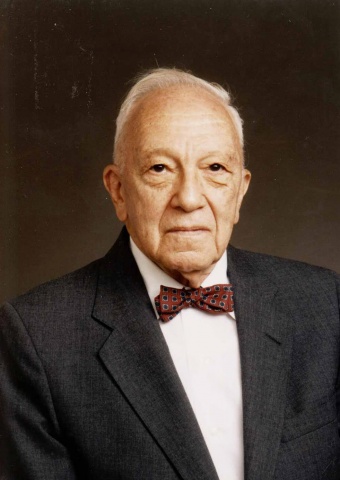Leonard Goldwater's vision: A history of the Division of Occupational and Environmental Medicine
For more than 30 years, the Duke Division of Occupational and Environmental Medicine (OEM) within the Department of Community and Family Medicine has been committed to improving the health of working populations. OEM offers comprehensive occupational health specialty services to businesses and organizations through a multi-disciplinary team of occupational physicians, nurses, industrial hygienists, ergonomic and safety professionals, toxicologists and epidemiologists with experience in all aspects of occupational and environmental health.

The division began with a vision by Leonard Goldwater, M.D., who began working at Duke University Medical Center in 1968. Goldwater was a well-recognized occupational health specialist who received a medical degree in 1928 from the New York University College of Medicine, then known as University and Bellevue Hospital College of Medicine. After World War II he became a professor of industrial hygiene at the Columbia University College of Physicians and Surgeons.
Duke Community and Family Medicine had begun in 1966 as the Department of Community Health Sciences, with E. Harvey Estes, Jr., M.D., as the first chair of the department. Estes, now distinguished service professor emeritus of community and family medicine, recalls that Goldwater approached him about starting an occupational health program at Duke.
“He had written several books and had a reputation of being a very good consultant to industry, particularly in the area of heavy metals and exposure to occupational hazards,” recalls Estes. “When the department started, I hadn’t really thought about an occupational health division. Leonard was, of course, attuned to it because he had been in the field for years. He approached me and said that we could form a division of occupational medicine that would do things that were needed in the community and, at the same time, instruct new house officers and physicians as to how to take care of the needs of employers.”
This new idea worked quite well, Estes says.
“Duke is the biggest employer in Durham County, by far,” he says. “It employs more people than any other two places combined, so we knew we were in the business of taking care of our employees and that if we set up a division of occupational medicine, that could take care of the needs of our own personnel.”
Goldwater’s visions were brought to life with the establishment of an occupational health program at Duke in 1970.
“Leonard knew we could help our own community, or our employer, by setting up a first-grade consultative service that can be used in-house,” says Estes. “We could provide that same service for those that are employers outside of Duke, but in the vicinity. That’s what Leonard proposed to do and did do. He and his faculty set up programming that could serve employers in the area on a consultative basis.”
Woodhall “Sandy” Stopford, M.D., assistant professor of community and family medicine, became Goldwater’s first faculty member in 1973. He previously worked with Duke’s occupational medicine program as a Robert Wood Johnson Clinical Scholar, spending a year shadowing Goldwater.
“He [Goldwater] spent a lot of time looking at groups of workers, particularly workers exposed to mercury, and I’d look at the same groups he did,” he says. “I went to Indiana after that year and finished up a fellowship in family and community medicine and finished my internal medicine residency. Then I came back and joined the faculty in 1973.”
From program to division
Before bringing his ideas to Duke, Goldwater first went to The University of North Carolina at Chapel Hill with the idea for an occupational and environmental medicine program, says George W. Jackson, M.D., associate professor of community and family medicine.
“UNC has a school of public health, so it made a lot of sense to try and bring the program over there,” says Jackson. “But for whatever reason, UNC wasn’t initially interested so Leonard came over to Duke and talked to Harvey [Estes] about integrating it into his department.”
At the time of its creation, Jackson says the program was mostly a clinical service operation.
“It operated out of the [Marshall I.] Pickens building which was at that time a hodgepodge of programs,” says Jackson. “There was employee health, occupational health, the university health services, or campus health, and the student health service.”
Over the years, the programs housed at Pickens were defined as separate from one another. In 1981, OEM began a residency program, and in 1982, Jackson was hired to run the employee health program.
The Division of Occupational and Environmental Medicine was officially established in 1986 with Jackson as the first division chief.
“We had a resident and then it was decided that we really ought to pull this thing out and create a division,” says Jackson. “What we were doing in terms of employee health and occupational health, which we brought together, was sort of something very different … from family practice. It needed its own division.”
Goldwater’s legacy
Goldwater retired from Duke around 1976, but continued to stay involved by working with the Crayon Watercolor and Craft Institute, later named the Art and Creative Materials Institute (ACMI). This group looked at the safety of consumer products, specifically art materials.
Goldwater passed away July 2, 1992, in Chapel Hill, leaving behind a legacy spanning 60 years of dedicated work. Duke established the Leonard J. and Margaret F. Goldwater Professorship in Occupational Medicine, honoring Goldwater’s legacy as one of the true pioneers in the field.
Duke OEM today
Today, the Division of Occupational and Environmental Medicine (OEM) includes 16 faculty members, nearly 100 staff members and two residents. Division Chief Dennis Darcey, M.D., says there is a critical role for occupational health professionals to play in health care reform and in improving the health of working populations and their communities.
“Employers are increasingly making the connection between worker health and enhanced productivity and are looking for creative solutions to enhance total worker health,” he says.
Duke OEM’s many programs offer a wide range of services focused on creating solutions to those problems, including:
- Employee Occupational Health and Wellness (EOHW) serves the entire Duke University and Health System workforce with three closely aligned programs —Employee Occupational Health, LIVE for LIFE and the Personal Assistance Service — which emphasize a proactive approach to improving health and productivity and preventing disease.
- The Occupational Health Clinic at RTP provides occupational and environmental services to contracted employers throughout the Raleigh, Durham, Chapel Hill, and the Research Triangle Park (RTP) area. Services offered include employment exams, work-related injury and illness treatment, drug testing, disability assessments and more.
- The OEM Residency Program began in 1981 and is accredited by the Accreditation Council for Graduate Medical Education. The two-year program aims to train highly skilled physicians as leaders in academia, public health agencies, military occupational medicine and as corporate medical directors. The program has been supported through a National Institute of Occupational Safety and Health grant since 1983 and is affiliated with the North Carolina Occupational Safety and Health Education and Research Center, a collaborative effort between Duke, The University of North Carolina at Chapel Hill and North Carolina State.
- The Epidemiology Research Program’s primary mission is to publish original occupational health and safety research on topics including occupational cancers, occupational respiratory diseases, occupational injuries, musculoskeletal disorders, work-related health disparities and workplace violence. Health and safety risks faced by construction workers and health care workers have been an area of research focus since program inception. Researchers also analyze data on Duke employees to advance internal interventions for Total Worker Health.
- Ergonomics provides hazard evaluation and training for upward of 35,000 Duke employees involved in every aspect of health care delivery and higher education, including all of the medical research and clinical laboratories, hospital and clinic work, office work, information technology, food preparation, maintenance, grounds keeping, housekeeping, and telecommunications.
- The Duke OEM Toxicology Program provides toxicology risk assessment services to over 400 domestic and international companies, and has evaluated more than 40,000 commercial and consumer products for hazard labeling requirements under state, federal and international laws.
- Occupational Mental Health Services are designed to help build and maintain a healthy and productive workplace. Services include consultations, corporate presentations, counseling and traditional employee assistance, and care management.
For more information about the Division of Occupational and Environmental Medicine, visit oem.duke.edu.
Leah Komada was a communications intern for Duke Community & Family Medicine. She recently graduated from UNC-Chapel Hill with a major in media and journalism.
